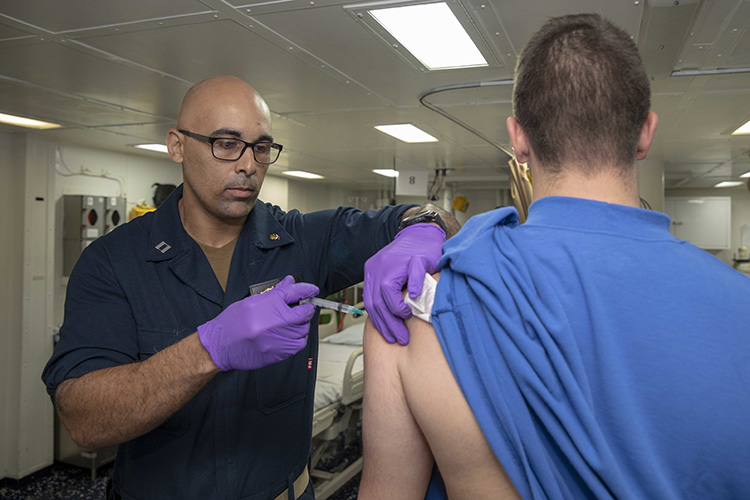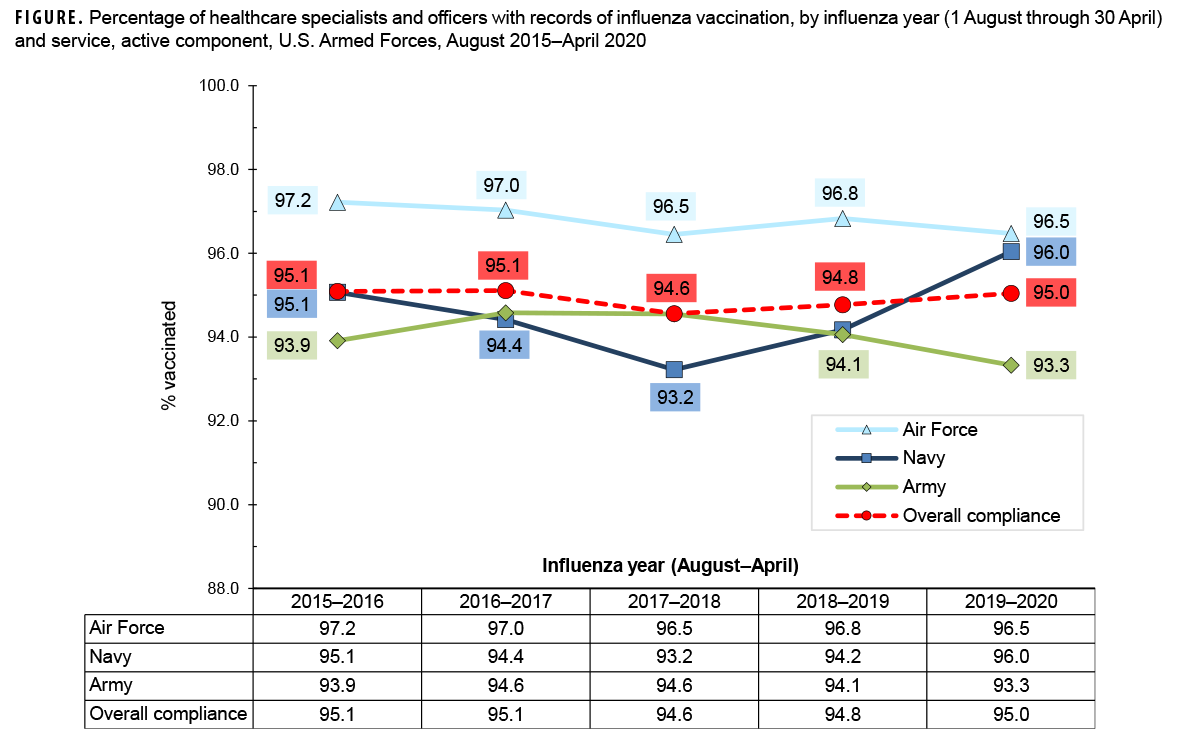Surveillance Snapshot: Influenza Immunization Among U.S. Armed Forces Healthcare Workers, August 2015–April 2020
 NORFOLK (Oct. 15, 2019) Lt. Sipriano Marte administers an influenza vaccination to Airman Tyler French in the intensive care unit aboard the Wasp-class amphibious assault ship USS Kearsarge (LHD 3). Kearsarge is underway conducting routine training. (U.S. Navy photo by Mass Communication Specialist Petty Officer 3rd Class Jacob Vermeulen/Released)
NORFOLK (Oct. 15, 2019) Lt. Sipriano Marte administers an influenza vaccination to Airman Tyler French in the intensive care unit aboard the Wasp-class amphibious assault ship USS Kearsarge (LHD 3). Kearsarge is underway conducting routine training. (U.S. Navy photo by Mass Communication Specialist Petty Officer 3rd Class Jacob Vermeulen/Released)
10/1/2020
By:
Armed Forces Health Surveillance Branch Communications Team
The U.S. Advisory Committee on Immunization Practices recommends that all healthcare personnel be vaccinated against influenza to protect themselves and their patients.1 The Joint Commission’s standard on infection control emphasizes that individuals who are your infected with influenza virus are contagious to others before any signs or symptoms appear. The Joint Commission requires that healthcare organizations have influenza vaccination programs for practitioners and staff and that they work toward the goal of 90% receipt of influenza vaccine. Within the Department of Defense, seasonal influenza immunization is mandatory for all uniformed personnel and for healthcare personnel who provide direct patient care and is recommended for all others (excluding those who are medically exempt).2–4
This snapshot covers a 5-year surveillance period (August 2015–April 2020) and presents the documented percentage compliance with the influenza immunization requirement among active component healthcare personnel of the Army, Navy, and Air Force. During the 2019–2020 influenza season, each of the 3 services had compliance rates of 93.3% or higher among healthcare personnel (Figure). For all services together, the compliance rate was 95.0%, very similar to the rate from the previous year.
References
-
Centers for Disease Control and Prevention. Immunization of health-care personnel: recommendations of the Advisory Committee on Immunization Practices (ACIP). MMWR Recomm Rep. 2011;60(RR-7):1–45.
-
Headquarters, Departments of the Army, the Navy, the Air Force, and the Coast Guard. Army Regulation 40-562, BUMEDINST 6230.15B, AFI 48-110_IP, CG COMDTINST M6230.4G. Medical Services: Immunizations and Chemoprophylaxis for the Prevention of Infectious Diseases. 7 October 2013.
-
Assistant Secretary of Defense (Health Affairs). Policy for Mandatory Seasonal Influenza Immunization for Civilian Health Care Personnel Who Provide Direct Patient Care in Department of Defense Military Treatment Facilities. Health Affairs Policy 08-005. 4 April 2008.
-
Assistant Secretary of Defense (Health Affairs). Addition of Pandemic Influenza Vaccine or Novel Influenza Vaccine to the Policy for Mandatory Seasonal Influenza Immunization for Civilian Health Care Personnel Who Provide Direct Patient Care in Department of Defense Military Treatment Facilities. Health Affairs Policy 11-010. 28 July 2011.

You also may be interested in...
Report
Jul 1, 2024
 .PDF |
1.38 MB
.PDF |
1.38 MB
The Medical Surveillance Monthly Report for July 2024 is a peer-reviewed journal of the Armed Forces Health Surveillance Division.
Report
Jun 1, 2024
 .PDF |
2.66 MB
.PDF |
2.66 MB
This 508-compliant PDF of the June 2024 issue of MSMR comprises the first part of the annual burden of morbidity issue, featuring an overview of absolute and relative morbidity burdens attributable to various illnesses and injuries among U.S. active component service members in 2023; with reports on both hospitalizations and ambulatory care visits ...
Report
May 1, 2024
 .PDF |
3.55 MB
.PDF |
3.55 MB
The May 2024 MSMR features a report on mortality surveillance of active duty U.S. soldiers from 2014 to 2019; followed by three related reports on respiratory investigations, surveillance and forecasting, on: an outbreak of influenza and SARS-CoV-2 at the Armed Forces of the Philippines Health Service Education and Training Center, September–October ...
Report
Apr 1, 2024
 .PDF |
1.52 MB
.PDF |
1.52 MB
508-compliant PDF of MSMR Vol 31 No 4 April 2024
Report
Mar 1, 2024
 .PDF |
1.34 MB
.PDF |
1.34 MB
The March 2024 MSMR features a comparison of 2018 estimates from the HRBS and the PHA on tobacco and nicotine use among the U.S. military active component; followed by a report on coverage of HIV PrEP among active duty service members in 2023; supplemented by a Surveillance Snapshot of HIV PrEP prescriptions in 2023 in the active component; then a ...
Report
Feb 1, 2024
 .PDF |
1.07 MB
.PDF |
1.07 MB
This is the February 2024 issue of MSMR—Medical Surveillance Monthly Report.
Report
Jan 1, 2024
 .PDF |
1.11 MB
.PDF |
1.11 MB
January 2024 issue of MSMR
Report
Dec 1, 2023
 .PDF |
3.39 MB
.PDF |
3.39 MB
MSMR volume 30 number 12, December 2023
Report
Nov 1, 2023
 .PDF |
1.07 MB
.PDF |
1.07 MB
MSMR November 2023 volume 30 issue 11
Report
Oct 1, 2023
 .PDF |
1.29 MB
.PDF |
1.29 MB
The October 2023 Medical Surveillance Monthly Report (MSMR) provides a review of the incidence of colorectal cancer among active component service members from 2010 to 2022; followed by a study of force protection risks in AFRICOM, INDOPACOM, and SOUTHCOM due to rapid diagnostic test failures for P. falciparum malaria from 2016 to 2022; then an update ...
Report
Sep 1, 2023
 .PDF |
1.30 MB
.PDF |
1.30 MB
The September 2023 MSMR provides the annual update of routine screening for antibodies to HIV among the active and reserve components of the U.S. Armed Forces; followed by a serological survey of Ross River virus (RRV) infection among U.S. Marine expeditionary forces who train in Australia; followed by a Surveillance Snapshot of the 10 leading ...
Report
Aug 1, 2023
 .PDF |
1.02 MB
.PDF |
1.02 MB
The August 2023 MSMR provides the most recent data from the active surveillance program for acute respiratory disease and Group A Beta-Hemolytic Streptococcus among U.S. Army basic trainees; then summarizes the case report of an extensively resistant E. coli in a returning traveler at Hawai'i's Tripler Army Medical Center; followed by a Surveillance ...
Report
Jul 1, 2023
 .PDF |
1.30 MB
.PDF |
1.30 MB
This continuation of the June issue, which published the annual quantification of health care provided by the Military Health System, continues with the impacts of various illnesses and injuries in 2022 among deployed service members; medical evacuations out of theaters of military operation; health care provision to non-service member MHS ...
Report
Jun 1, 2023
 .PDF |
1.55 MB
.PDF |
1.55 MB
This annual issue quantifies the impacts of various illnesses and injuries in 2022 among members of the active component of the U.S. Armed Forces as well as the U.S. Coast Guard; health care burden metrics include the total number of medical encounters, including hospitalizations and ambulatory services, as well as numbers and types of individuals ...
Report
May 1, 2023
 .PDF |
1023.59 KB
.PDF |
1023.59 KB
The May 2023 MSMR reintroduces a monthly reportable medical event (RME) summary for the active component and MHS beneficiaries; then features a review of enhanced mpox outbreak case detection among MHS beneficiaries through ESSENCE (Electronic Surveillance System for the Early Notification of Community-based Epidemics); followed by a report on ...
You are leaving Health.mil
The appearance of hyperlinks does not constitute endorsement by the Department of Defense of non-U.S. Government sites or the information, products, or services contained therein. Although the Defense Health Agency may or may not use these sites as additional distribution channels for Department of Defense information, it does not exercise editorial control over all of the information that you may find at these locations. Such links are provided consistent with the stated purpose of this website.
You are leaving Health.mil
View the external links disclaimer.
Last Updated: July 11, 2023